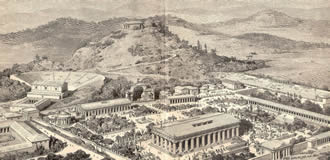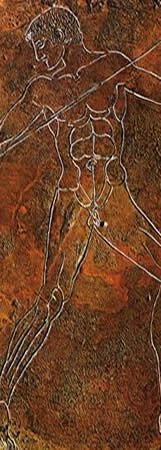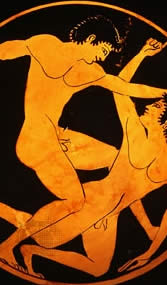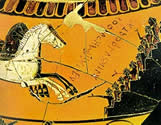
















Ancient olympia history


>>
Olympics
776 BC – 728 BC, Only one event
In the beginning there were only one event, a single foot race. The race was called the “Stade” and was the only event for 13 Olympics. An approx. 185 metres race, the first times on a straight strip of grass. The first athlete ever to win an Olympic race was a young cook from Elis, named Koroibus who received a wreath of wild olive leaves as his prize. This prize was through the centuries not only an honour for the winner but also for his family and city.
724 BC – 712 BC, More races
The straight “Stade” was changed to an oval racing track and an one-lap sprint was called a “Stadium” which name today is used for a sports arena all over the world. New running events were added from the 14th Olympics, two laps (approx. 370 metres) and in the next Olympiad a 12 laps race. In the 16th Olympiad the long distance race 24 laps started.
708 BC, Other sports are introduced
In 708 BC, at the 18th Olympiad, when more city states participated, especially the Spartans the first combat sport was introduced: Wrestling. At the same games pentathlon were introduced: Jumping, javelin, running, discus and wrestling, all performed in the same afternoon.
688 BC, Boxing is introduced
At the 20th Olympiad in 688 BC one of the most popular Olympic sports even today was introduced: Boxing. The gloves were made of straps of soft ox-hide. The boxing matches had no time limit and ended if the fighter fell to the ground or one of the fighters held up one or to fingers to show that he admitted defeat. There were no weight categories, opponents were chosen by random.
680 BC, Equestrian sports
Equestrian sports was introduced in 680BC. The stadium was to small for the Four Horse Chariot Race so the horse racing was held at the hippodrome next to the stadium.
648 BC, Pancration, a different fighting art
A new sport event that was introduced at the 33rd Olympics in 648 BC, , which not exists today at the Olympics, was Pancration. A combination of boxing and wrestling, a sport of rather violent and unrestrained nature in ancient Greece. The sport exists still but today with modified rules.
632 BC, the Olympics is extended
632 BC the Olympic Games was extended to seven days. The games was still in honour of the goods so the first day was for preparatory ceremonies and sacrifices. The next five days was the competition and the seventh day was the award of prizes and the feasting. In 632 was also boxing and wrestling contests for boys introduced.
580 BC, Armour ruinning
580 BC heavily armed men was competing in Armed Race, two laps around the stadium.
500 BC , 50 events
There were more than 50 events.
Ancient Greek athletes were naked when they competed, to display their physical prowess and also to pay homage to Zeus by showing him how they had trained their bodies to their physical peak. An athlete’s physical perfection could also be intimidating to his competitors, and external beauty represented each competitor’s internal beauty and demonstrated their
desire for a balance between body and mind. Athletes were often an inspiration to artists and sculptors, who used the athlete’s physical prowess and movements to inspire their work. This can be seen in archaeological finds dating from that time. Because they were not covered by clothing, athletes took great care to protect their skin. Before starting the day’s training or competition, athletes would rub their body with olive oil then dust themselves with fine sand. This helped to regulate their body temperature and protect them from the sun. After competing, athletes would scrape off the sweat, oil and sand with a curved tool called a strigil. Then they would be washed using water and a sponge.
Combat sports in the ancient Olympic Games included wrestling, boxing and pankration. Wrestlers would grapple to gain hold of their opponent, and the loser was the first one forced to touch the ground three times. Boxers fought with their hands bound and protected by leather thongs, but - unlike modern boxing - pieces of metal were added to their knuckles
to increase the effectiveness of the punches. In the no-holds-barred event pankration, all moves were allowed, including gouging eyes and pulling noses. Probably the toughest discipline was the pentathlon, a series of five events: running, jumping, discus throwing, javelin throwing and wrestling. The athletes who competed in this discipline (called pentathlos by the Ancient Greeks) were acclaimed as among the best competitors in the ancient Olympic Games. There were also equestrian events, with chariot racing and horse riding in the hippodrome. In the horse races, the jockeys were naked and rode bareback. Chariots were pulled either by two horses (biga) or four horses (quadriga), and the charioteers
wore long robes. The chariot races were often hugely spectacular and proved particularly popular with the people watching the ancient Olympic Games







